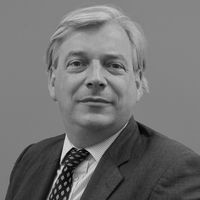Could you profit from Pearson?
In an unpromising sector, educational publisher Pearson stands out, having announced its best-ever operating profit this week. Share tipster Charlie Gibson examines whether you should buy in.

"Journalism consists in buying white paper at two cents a pound and selling it for ten cents a pound." Such was the damning indictment of the press from Cyril Connolly, former editor of The New Statesman, The Observer and The Sunday Times. Would that it were true today. The newspaper industry may once have made margins of 80%, but it certainly doesn't now. It's tough to make money in print media and out of media on the internet too. Still, as ever, that doesn't mean there aren't opportunities out there. Indeed, my model has just for the first time thrown up a media company, one that mainly uses pink paper and that really looks like it might be a good buy.
The publisher of the FT and the world's largest publisher of educational material, Pearson (PSON, 790p), announced its results earlier this week. Despite reporting its best-ever operating profits and better-than-expected earnings, the share price soon began to lag. The best explanation is that there was a bit of disappointment about, because nothing new was said about potential merger and acquisition activity but it still seems a bit unfair to me. Adjusted earnings for 2006 were 18% ahead of the previous year, with margin increases across all three areas of the business. What's more, it looks as if the growth will continue perhaps not at such a rapid pace, but at a very acceptable one.
Underlying sales increases of between 3% and 6% are expected at the company's two largest units (accounting for 61% of group adjusted operating profits), while margins are expected to increase at four of the its six units, accounting for 56% of profits. I doubt that the margin increase in 2007 will be as good as in 2006. But I still expect Pearson's overall margin this year to be about 14.5%, compared to 13.8% in 2006. Superimpose that onto underlying sales growth, knock a bit off net finance costs on account of the sale of Government Solutions to a private-equity buyer for in excess of $600m, and shave the marginal tax rate for deductions relating to the amortisation of goodwill arising on acquisitions, and I reckon it's possible Pearson will make around 44.5p in underlying earnings per share (EPS) in 2007, compared with 40.2p in 2006 on a constant currency basis. That's a 10.6% rise.
MoneyWeek
Subscribe to MoneyWeek today and get your first six magazine issues absolutely FREE

Sign up to Money Morning
Don't miss the latest investment and personal finances news, market analysis, plus money-saving tips with our free twice-daily newsletter
Don't miss the latest investment and personal finances news, market analysis, plus money-saving tips with our free twice-daily newsletter
There is bad news, however. It comes in that last phrase on a constant currency basis'. Pearson makes about two-thirds of its sales in dollars and each 5c weakening in the exchange rate costs the company about 1p in EPS. In 2006, the exchange rate averaged $1.84 to the pound. So far this year, it has been around $1.95. So it looks as if that 44.5p may have to be adjusted downwards by a couple of cents. Even so, I'd expect growth of around 6% this year and the market is going for a further increase of around 7% in 2008. At the same time, since 2000 Pearson has traded pretty consistently on an historic multiple of between 18 and 22 times adjusted EPS.
At the moment, it's on a rating mid-way between the two at 20.4 times. Volatility in Pearson's shares has virtually disappeared since the dotcom crash. Nevertheless, feeding all of the above data into my model suggests that the shares are now trading towards the lower end of their allowed range and that investors could expect a return anywhere up to 25% from current levels as long as there are no major changes in external circumstances. Given that there is so little volatility in the shares,
I think it might not be worth waiting for all that gain. I'd buy now and sell above 900p. It's not the stuff that dreams are made of, but I think the downside risks are limited and the likely returns are more than acceptable.
Now one to sell. Smith & Nephew (SN, 593p) is a fantastic company, it's just that I also think its shares have got a little ahead of themselves recently. Back in 2002, when underlying earnings were increasing at over 20%, it was rewarded by the stockmarket with a rating of over 30 times historic earnings. Like Pearson, however, this maker of high-quality medical equipment makes most of its money in dollars. As earnings growth in sterling terms slipped to just under 10% last year, so its rating was pared back to 20 times. As a result, last year Smith & Nephew moved to change its reporting currency to US dollars for the first time. When it announced its full-year results earlier this year, diluted adjusted EPS was 45c, or around 25p. The problem is that in sterling terms growth pretty much grinds to a halt this year. It should revert to somewhere in the mid-teens as a result of new product launches and the group's margin improvement plan in the years after that.
But even if it does, and even if we think Smith & Nephew deserves to trade on a historic multiple of 25 times (roughly where it is now), on forecast earnings of 25.53p per share for 2007, that translates into an implied share price of 638p or just 4% above current levels in a year's time. The firm has proved a superb long-term investment, but in short term I can't see any upside. At this level, my model indicates it's time to book some profits. I would look to return to the stock in about 12 months' time if the price is back to around 560p.
Charlie Gibson is an analyst and private investor
Get the latest financial news, insights and expert analysis from our award-winning MoneyWeek team, to help you understand what really matters when it comes to your finances.
Charles has previously written for the MoneyWeek, giving readers his share tips regularly and covering other topics on the side such as stock markets and the economy. He has also written for The Business, Shares, Investors Chronicle and The Evening Standard, and Charles has presented on LBC and been a guest on BBC One and BBC World. Aside from his journalist background, Charles graduated as a chemist from the University of Oxford specialising in ligand gated ion channels.
-
 What are my retirement income options?
What are my retirement income options?We’re all told to save into a pension, but there’s widespread confusion about how to take an income from our savings and investments at retirement, a new study has found. We look at your retirement income options.
-
 UK interest rates: will the Bank of England lower rates?
UK interest rates: will the Bank of England lower rates?The Bank of England’s Monetary Policy Committee’s (MPC) final interest rates decision will be announced today and most experts expect a cut
